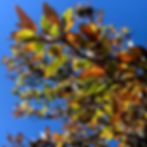
San Antonio, Texas
Oak Wilt in San Antonio
All About Oak Trees
Most Oak trees like Red-Oak & Post-Oak are "Deciduous", meaning they will drop all their leaves in the fall. This begins with the leaves changing color and eventually turning completely brown before falling off. The seasonal color change makes identifying oak-wilt in the fall a bit more difficult.
The Live Oak is an exception to this group.
Live Oaks are actually "Evergreen" trees, meaning they will retain their dark green, leathery leaves throughout the year.
Just before the live-oaks start producing pollen in the early spring, they drop all of their old leaves while still keeping some green leaves on the tree. This gives the tree a green appearance year round.
Some years, the live-oaks will shed a ton of leaves, while other years dropping not nearly as much.
Just like the Deciduous trees, this seasonal color change makes identifying oak-wilt in the spring a bit more difficult.

Live Oak

Red Oak

Post Oak

Live Oak
Most common Oak Trees in
San Antonio
What is Oak Wilt?
March 31, 2024, San Antonio, Texas.
Oak Wilt is a fungal infection that is most commonly spread by beetles that feed on sap from other wounded trees. This fungus kills trees by causing their water vessels to close, resulting in a dead canopy.
Once the canopy dies, saving the tree becomes almost impossible. Due to the lack of photosynthesis, the tree dies completely within no time.
In San Antonio, our Live Oaks, Red Oaks, and Post Oaks are all affected by oak wilt, Red Oak being the most vulnerable.. (What kind of tree do I have?)
There are ways to prevent and also treat oak wilt through the use of medication, although some argue that there is no guarantee in the results.
Once oak-wilt takes over, it can sometimes kill a tree within a few weeks depending on the severity.
How Oak Wilt Gets Into a Tree
Sap beetles are attracted by wounds in a tree, such as breakage from a storm, pruning cuts, and involuntary mechanical damage. When a sap beetle feeds on an infected tree and then moves to a healthy tree with a wound, the disease is transmitted to the vascular tissue of the other tree.
The tree then tries to fend off the intruder by walling off its cells, which causes leaves to wilt and brown, and eventually killing branches and the entire tree. Oak wilt is a rapidly progressing disease that usually kills a tree within just a few weeks.




A second way how the disease can spread is through natural root grafts, which occur when roots of trees of the same species, such as two red oaks, grow together. Oak wilt fungus can move more than 50 feet through the root systems of interconnected trees.
That makes the disease especially challenging to control once it’s in a neighborhood.
The fungus continues to spread until there are no oaks left, at that point it will disappear because it needs live tissue to survive.
Once you know what type of Oak tree you have,
and you understand what time of year your tree's leaves are supposed to be green vs. when they should start changing colors, you can begin looking for signs of Oak-Wilt with confidence. (What kind of tree do I have?)
How to identify Oak-Wilt
The first sign of oak wilt is a rapid wilting and browning of the leaves in late spring to early summer, followed by the leaves dropping.
This starts at the top of the tree, which is not easy to inspect in tall trees. Use binoculars to take a closer look.
The browning of the leaves starts at the margins of the leaf at the apex, which is the tip of the leaf. From there it progresses downwards along the margins towards the leaf stem. The browned leaves drop to the ground.
Another symptom is vertical cracks in the bark with mat-like fungal spores underneath. The bark swells and eventually ruptures from the pressure created by the growing fungus.
In the following you might also notice sap beetles. While feeding on the sweet-smelling fungal mat, these beetles, about one-quarter to one-eighth of an inch, pick up the spores and thereby spread the disease further.
What does Oak-Wilt Look Like?
Identifying oak-wilt can be difficult for the untrained eye.. Here are some images that show what to look for..




Great news, we do FREE Tree Inspections!
If you are concerned about your tree, please message me to set up an appointment.
